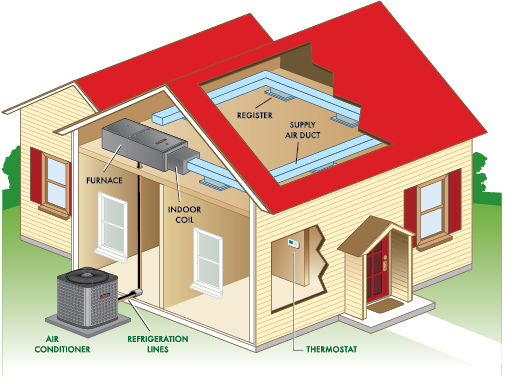A Crash Course in Furnaces

It's somewhere below 0 on this Chicago morning and I woke up realizing just how happy I am that my furnace kept the house warm all through the cold night. Let's all take a moment to be thankful for our furnaces actually... go ahead, I'll wait....
OK, now for the fun stuff:
When you understand how your furnace works, you'll know how to keep it running and if needed, how to replace it; unless you'd rather roast chestnuts on an open fire to keep warm this winter.
Basic Heating Cycle
- A forced-air furnace heats your home through a heating cycle that looks like this:
- Natural gas or propane is ignited in the burner.
- The flames heat up a metal heat exchanger and exhaust out of the flue.
- The heat exchanger transfers its heat to the incoming air.
- The furnace's blower forces the heated air into the ductwork and distributes it throughout the home.
- As the warm air fills each room, the colder, denser air is drawn back into the furnace via the return ducts, repeating the process.
Gas Furnace Components
There are many components that work together in a furnace to help keep you comfortable. With so many types of models on the market, it can be tough to know what they are and their functions.
- Thermostat: A temperature activated switch that when calling for heat (indoor temperature dips below a set point) tells a control board inside the furnace to begin the heating cycle by turning on an ignition switch.
- Draft Hood/Fan: Air is drawn into the burners and mixes with gas to create combustion. On high-efficiency models, a draft-induced fan makes combustion leaner and more fuel efficient.
- The fan also directs the heat from the burners into the heat exchanger where exhaust gases are vented outside of the home.
- Burners: Like a gas grill, furnace burners are a set of tubes through which gas is directed and burned.
- A gas valve, igniter, and flame sensor all work together to control the flames.
- When the system calls for heat, the gas valves open and the mixture is ignited.
- The flame sensor is a safeguard that shuts off the incoming gas if a flame isn't detected.
- Heat exchanger: A series of metal tubes that are heated by the burners in order to warm the inside air. As gas combusts inside the heat exchanger, these metal baffles get hot and transfer their radiant heat into the passing air. Any damage to the heat exchanger could let combustion gases leak into the house air. High-efficiency furnaces may add additional heat exchangers with curved surfaces (slow down air flow) to increase the rate of heat transfer.
- Blower: The blower fan directs air coming from return ducts into the hot heat exchanger. The heated air is then forced throughout the home's ductwork. Many furnaces will have a "multi-speed" blower that is preset at the time of installation. Higher efficient furnaces come with a variable speed blower that can self-adjust fan speed during operation.
- Flue: A flue vent collects the spent combustion gases used to create heat and carries them outside the home. Galvanized steel is typically used on standard efficiency units, while high-efficiency units use easy-to-install polypropylene venting.
Beyond Basic Functions Now that you know how basic furnace components work together to keep you comfortable, it will be easier for you to make a selection about which features are important when picking the perfect furnace. Next, we'll take a deeper look at those features and key considerations you should make for your next furnace.


